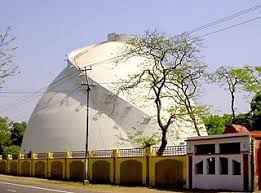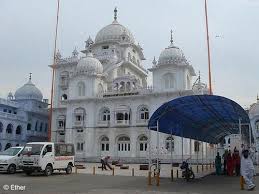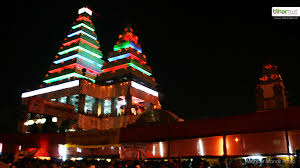PATNA
Patna, earlier known as Patliputra, is one of the most ancient cities of India, situated on the banks of the holy river Ganga. Being the capital of Bihar, Patna is known for its magnificent past and the historical buildings.
Patna is the gateway to the Buddhist and Jain pilgrim centers of Vaishali, Rajgir, Nalanda, Bodhgaya and Pawapuri, all located in the state of Bihar.
Patna is located on the south bank of the Ganges River and it has a very long riverline. It is surrounded by rivers—the Ganga, the Sone, and the Poonpun. In the north of Patna, flows another popular river, the Gandak .
The summer temperatures of Patna rise very high as the hot tropical sun beats down with all its intensity coupled with a heat wave and it has high humidity throughout the year.
 |
| (Patali, literally Trumpet flower) |
Historical Background
Patna has been known by different names : Pataligram, Pataliputra, Pa-lin-fou,Palibothra, Kusumpur, Pushpapura, Azimabad, and the present day Patna.
Patna derives its name from the word Pattan, which means port in Sanskrit. It may be indicative of the location of this place on the confluence of four rivers namely Ganga , Sone, Punpun, Gandak, which functioned as a port.
It is also believed that the city derived its name from Patan Devi, the presiding deity of the city, and her temple is one of the Shakti Peethas.
One legend ascribes the origin of Patna to a mythological king, Putraka, who created Patna by a magic stroke for his queen Patali, literally Trumpet flower, which gives it its ancient name Pataligram (Gram is the Sanskrit for a village) It is said that in honour of the first born to the queen, the city was named Pataliputra (Putra means a son).
Ajatashatru, is thought to have ruled from 491-461 BCE and moved his capital of the Magadha kingdom from Rajgriha to Patliputra.Ajatasatru with the help of his two ministers Sunidh and Vassakara built a fort near the banks of River Ganges to strengthen the defence of Magadha and named it Patli Grama(village) .Later it got developed into a city, which soon became popular as Patliputra,which is now known as Patna, the capital of Bihar. Udayabhadra eventually succeeded his father, Ajatashatru. Under him Patliputra became the largest city in the world.
According to Mahaparinirvana sutta, when Patliputra was being erected, by chance the Buddha came there and praised the city of Patliputra, and pointed three things which may prove fatal to the city i.e. Fire, water and mutual split among the people.
Pataliputra, was the capital of the Magadha Empire under the Haryanka, Nanda, Mauryan(Chandragupta Maurya, Bindusara & Ashoka), Sunga, Gupta (Chandragupta I, Samudragupta,Chandragupta Vikramaditya,Kumaragupta I and Skandagupta),Pala and Suri dynasties.
When the Bengal Presidency was partitioned in 1912 to carve out a separate province, Patna was made the capital of the new province of Bihâr and Orissa.
The city limits were stretched westwards to accommodate the administrative base, and the township of Bankipore took shape along the Bailey Road (originally spelt as Bayley Road, after the first Lt. Governor, Charles Stuart Bayley. This area was called theNew Capital Area.
Places of Interest in Patna
Golghar
 |
| Golghar near Gandhi Maidan |
The huge, beehive structured building was built to store grains, following a terrible famine in 1786. The 29 meter high building offers a scenic view of river Ganga and Patna city. This granary was never used for the desired purpose.
Buddha Smriti Park
 |
| Buddha Smriti Park near Railway station in Patna |
Relics of the Buddhist era brought from Sri Lanka, Japan, Thailand, Myanmar and South Korea were installed in the Park built by Bihar government to commemorate the 2550th anniversary of ‘mahanirvana’ (salvation) of Lord Buddha.Tibetan spiritual leader, the Dalai Lama, planted a sapling of the Mahabodhi banyan tree brought from Sri Lanka on the occasion of Buddha Purnima.
A 126-feet tall stupa having three 'parikramas' will come up in the construction area. This is the place where urns containing ashes of Lord Buddha which were excavated in the 1950s will be kept. Apart from this, there will be 60 meditation rooms in five blocks facing the stupa, fully soundproof and air-conditioned, There will be a 'Park of Memories' on the campus which will have 34 miniature replicas of stupas sent by 34 countries. The campus will also have a museum of items connected to the life of Lord Buddha during his stay in Bihar. A multistoried car parking system is also under construction. Each of the three storeys will have the capacity to park 120 cars. The cars will drive up and down the ramp.
 |
| Museum in Patna |
MuseumThe city museum is a collection of metal and stone sculptures of the Maurya and Gupta Periods, terracota figurines and archaeological finds from different sites in Bihar. It has the Ashes of Buddha, image of Yakshini (3rd century BC), and a 16 meter long fossilized tree.
 |
| Har Mandir Sahib in Patna Saheb |
Har Mandir SahibA holy shrine of Sikhs, this is said to be the second-most important Gurudwara in India. The Gurudwara was built by Guru Gobind Singh, the 10th guru of the Sikhs. Built in white marbles, with kiosks on the terraces, it consecrates the birthplace of Guru Gobind Singh.
 |
| Khuda Baksh Oriental Library |
Khuda Baksh Oriental LibraryOne of the national libraries of India, it has a rare collection of Persian and Arabic manuscript. It also host paintings during Rajput and Mughal rule in India. A very unique collection; a One-inch wide Quran is also kept here.
 |
| Martyrs Memorial called Satmurty in Patna |
Martyrs Memorial
The memorial in front of the old secretariat, shows seven young men facing the bullets and sacrificing their lives during the '1942 Quit India movement'.
 |
| Hanuman Mandir near Patna Railway Station |
Hanuman MandirThe favourite Deity of the Patnaite. It is situated right in front of the Patna Junction, the central railway station of the City. Long winding queues can be seen at the temple on saturdays and tuesdays, the traditional worshipping days of the deity.
Qila House (Jalan House)
 |
| Qila House (Jalan House) in Patna city |
This houses is an interesting museum famous for its jade collection, Chinese paintings and other far eastern work of art, Collected by Diwan Bahadur Radhakrishan Jalan.
Darbhanga House
 |
| Darbhanga House in Patna |
 |
| Pillar found during excavation in Kumhrar |
This is also called as Nav Lakha building which was built by Maharaja Sir Kameshwar Singh of Darbhanga. This beautiful building on the banks of Ganges now houses the post graduate departments of Patna University. It houses the Kali Mandir, which has been a place of worship of the goddess.
KUMHRAR
Kumrahar is the remains of an ancient city of Pataliputra, located 5 km from Patna Railway Station, on Kankarbagh Road, Patna, Bihar.
The archaeological remains of the Mauryan period (322–185 BCE), has been discovered here. This include the ruins of a hypostyle 80-pillared hall . The excavation finding here dates back to 600 B.C , and marks the ancient capital of Ajatshatru, Chandragupta and Ashoka, and collectively the relics range from four continuous periods from 600 BC to 600 AD.
During excavation archeologists found the marks of ‘Arogya Vihar’ which was headed by famous physician Dhanvantri. One can visit Kumhrar to experience the glorious history of Pataliputra and the Magadh Empire.
Compiled by- Ravi Ranjan
Lecturer in Physics




